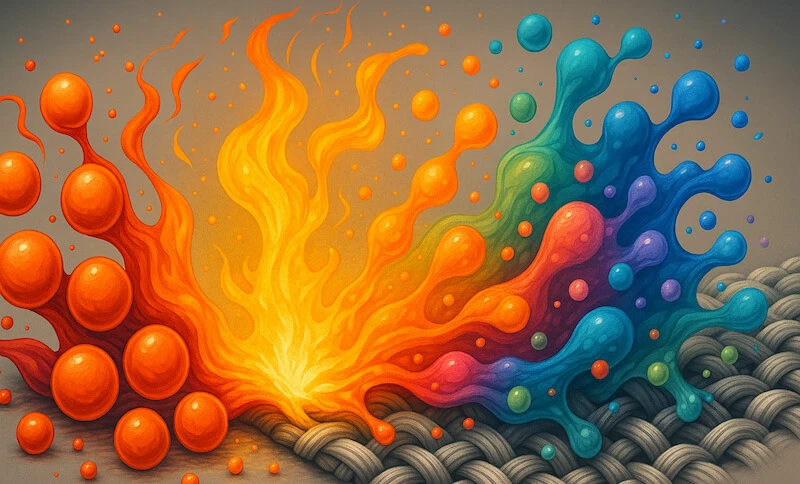When sublimation ink transfers from paper to polyester, the result is not a coating or a layer of ink, it’s a chemical bond. The printed colors become embedded within the material, creating a permanent and highly durable image.
That transformation isn’t about heat alone. It’s about chemistry on a molecular level, where dye particles are engineered to respond to temperature and pressure with a unique phase shift known as sublimation.
Sublimation inks are not like pigment or solvent inks. They’re formulated with solid-state dyes designed to activate only when they reach specific temperatures, typically between 375°F and 400°F (190–205°C). Below that threshold, the dye stays locked in solid crystalline form. Above it, something remarkable happens: the molecules absorb heat energy, expand, break hydrogen bonds, and jump from solid to gas without becoming liquid first.

What chemically allows sublimation dye to bypass the liquid phase?Sublimation ink uses disperse dyes, molecules with low vaporization energy and stable crystal structures. When heated, the molecular bonds weaken, the crystal lattice collapses, and the dye molecules gain enough kinetic energy to escape directly into gas form. This gas has an affinity for polyester polymers, diffusing into the material’s molecular pores before cooling and re-solidifying inside the fiber.
This reaction, known as endothermic phase transition, allows the dye to penetrate materials rather than sitting on the surface. Polyester becomes receptive during heat because its polymer chains temporarily loosen and open, creating pathways for vaporized dye molecules to migrate inward. When the material cools, those polymer chains contract again, trapping the dye inside – a process explained in more detail in how polyester’s polymer structure enables sublimation bonding.
This article breaks down the chemistry of sublimation inks, what they’re made of, how heat converts solid dye into gas, and how molecular energy and vapor pressure drive the sublimation process.
Key Takeaways
Sublimation inks are formulated with solid-state disperse dyes.
These dyes have a crystalline structure that remains stable until exposed to high heat.
Heat increases molecular kinetic energy.
As temperature rises, molecular vibration breaks the dye’s crystal lattice, enabling the solid-to-gas phase transition.
The sublimation point is driven by vapor pressure.
When vapor pressure exceeds atmospheric pressure, the dye escapes as gas rather than melting into liquid.
Time and applied pressure optimize gas diffusion.
Maintaining heat and pressure long enough allows dye gas to fully expand and migrate away from its solid form, ensuring a complete sublimation reaction.
Sublimation Inks Are Formulated With Solid-State Disperse Dyes
Sublimation relies on disperse dye molecules, solid-state colorants engineered to remain stable at room temperature yet transform predictably under heat. These dyes, often based on azo dyes or anthraquinone dyes, have a crystalline dye structure that keeps them inert during printing. In this solid state, the dye particle lattice is tightly packed, giving the dyes high stability at room temperature and preventing unwanted bleeding or premature activation.
What makes these dyes perform uniquely in sublimation is their hydrophobic nature and their molecular affinity for polyester. Polyester’s synthetic structure contains nonpolar regions and micro-pores that readily accept hydrophobic colorants, making polyester substrates and other synthetic fibers ideal hosts for sublimation transfer.
Before heating, the dyes are held in place by dye carriers within the ink, fluids that suspend the solid particles without dissolving them. When heat is applied, these thermally activated dyes absorb energy, destabilizing the lattice and enabling vaporization – explained in more detail below ↓. This is the core of dye sublimation chemistry: the move from an ordered solid crystal to free-moving gas molecules capable of penetrating polymer chains.
| 💡 Did you know? The size and uniformity of ink particles directly influence print sharpness and color saturation in sublimation? 🔗 Explore why particle size matters in sublimation. |
Once in vapor form, the dyes exhibit dye diffusion behavior, migrating into the loosened polyester matrix. This dye–polymer interaction, not a surface coating, is what creates the permanent, wash-resistant bond sublimation is known for. As the material cools, the polymer chains contract again, locking the dyes back into a solid-state form, now embedded inside the fiber rather than sitting on top.
Heat Increases Molecular Kinetic Energy
When sublimation starts, heat adds molecular kinetic energy to the dye. This is an endothermic reaction, meaning the dye absorbs energy rather than releasing it. As temperature climbs, the molecules begin to move and vibrate more intensely, building enough vibrational energy to reach their thermal activation energy, the point where a phase transition can occur.
Once this temperature threshold is met, the added energy weakens the dye’s intermolecular forces. The crystal lattice structure that normally holds the molecules in place begins to loosen, causing lattice breakdown and hydrogen bond disruption. Instead of melting, the dye uses this energy to jump straight into a gas, what we describe as solid-to-gas conversion.
This happens because the molecules now have the molecular mobility required to escape the solid form without breaking down chemically. Unlike thermal decomposition, which damages material, sublimation keeps the dye molecules intact and simply moves them into a higher-energy excitation state.
All of this follows the basic thermodynamics of sublimation: as the dye absorbs more energy (measured in joules) and moves through a predictable rise on a heating curve, it eventually overcomes its activation energy barrier. At that moment, the dye transitions into vapor and becomes ready to migrate into the polyester surface.
The Sublimation Point is Driven by Vapor Pressure
Sublimation depends on how vapor pressure builds inside the dye as it heats. Each dye has a specific sublimation point, where its internal pressure rises high enough to overcome surrounding atmospheric pressure. When this happens, the dye reaches vapor pressure equilibrium, and molecules shift into the gas phase.
This shift is driven by vaporization energy, the energy needed for dye molecules to develop enough force to escape their surface. As the dye approaches its saturation point, small pressure gradients form, increasing the partial pressure of dye vapor around the surface. Once the dye’s vapor pressure surpasses the external pressure, gas-phase dye molecules begin to release and expand outward.
Once in gas form, the molecules behave according to ideal gas principles, expanding freely, spreading out through gas diffusion, and occupying more space through gas expansion. This is why sublimation requires precise heat control: the dye must reach the exact point where vapor pressure and temperature intersect on a vapor pressure curve, supported by the dye’s specific heat of sublimation and the universal gas constant (R).
When these conditions align, the dye becomes a stable vapor capable of penetrating polyester and completing the sublimation transfer.
Time and Applied Pressure Optimize Gas Diffusion
In sublimation, gas diffusion only works when heat, time, and pressure are balanced. Dwell time determines how long vaporized dye has access to the substrate. Too little time means the gas diffusion rate is low and the dye can’t move far into the material. Too much time can cause desorption, where dye vapor begins to escape instead of staying embedded.
Pressure works differently. Applying the right PSI creates uniform contact between the transfer sheet and the substrate, enabling pressure-assisted transfer. This stabilizes the vapor path and prevents gaps where dye gas could escape. Excessive pressure, however, restricts gas expansion and penetration, preventing the dye from spreading evenly.
During heating, the substrate undergoes thermomechanical softening, allowing polymer chain relaxation. This increases material permeability and fiber porosity, opening temporary channels for dye migration. The interaction between heat and pressure determines the dye’s diffusion coefficient—how easily the gas penetrates.
Correct heat press conditions, temperature paired with the right transfer dwell time (seconds) and controlled PSI, ensure dye vapor enters the polymer network instead of sitting between the sheet and the surface. As cooling begins, these pathways close, trapping the dye through dye entrapment and locking it in during the cooling phase.
In short:
- Too little time = poor diffusion
- Too much time = dye vapor escapes
- Too little pressure = inconsistent transfer
- Too much pressure = blocks gas movement
- Balanced time + pressure = maximum dye penetration
Related Topics
